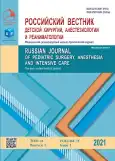Aplasia of the superior vena cava and persistent superior left vena cava in a 3-year-old child: Case report
- 作者: Lazarev V.V.1,2, Linkova T.V.2, Negoda P.M.2, Shutkova A.Y.2, Gorelikov S.V.2, Naleyev A.A.2, Polanskaya M.V.2, Bykov M.V.3
-
隶属关系:
- N.I. Pirogov Russian National Research Medical University, Moscow, Russia
- Russian Children’s Clinical Hospital
- N.I. Pirogov Russian National Research Medical University
- 期: 卷 11, 编号 1 (2021)
- 页面: 85-90
- 栏目: Case reports
- URL: https://journals.rcsi.science/2219-4061/article/view/123435
- DOI: https://doi.org/10.17816/psaic940
- ID: 123435
如何引用文章
全文:
详细
BACKGROUND: Structural features of the patient’s vascular system can cause unintended complications when providing vascular access and can disorient the specialist in assessing the location of the installed catheter. This study aimed to demonstrate anatomical features of the vascular system of the superior vena cava and diagnostic steps when providing vascular access in a child.
CASE REPORT: Patient K (3 years old) was on planned maintenance of long-term venous access. Preliminary ultrasound examination of the superior vena cava did not reveal any abnormalities. Function of the right internal jugular vein under ultrasound control was performed without technical difficulties; a J-formed guidewire was inserted into the vessel lumen. X-ray control revealed its projection in the left heart, which was regarded as a technical complication, so the conductor was removed. A further attempt to insert a catheter through the right subclavian vein led to the same result. For a more accurate diagnosis, the child underwent computed angiography of the superior vena cava system. Congenital anomalies of the vascular system included aplasia of the superior vena cava and persistent left superior vena cava. Considering the information obtained, the Broviac catheter was implanted under ultrasound control through the left internal jugular vein without technical difficulties with the installation of the distal end of the catheter into the left brachiocephalic vein under X-ray control.
CONCLUSION: A thorough multifaceted study of the vascular anatomy helps solve the anatomical issues by ensuring vascular access and preventing the risks of complications.
作者简介
Vladimir Lazarev
N.I. Pirogov Russian National Research Medical University, Moscow, Russia; Russian Children’s Clinical Hospital
Email: lazarev_vv@inbox.ru
ORCID iD: 0000-0001-8417-3555
SPIN 代码: 4414-0677
Dr. Sci. (Med.), Professor
俄罗斯联邦, 117 Leninsky Av., Moscow, 119571Tatiana Linkova
Russian Children’s Clinical Hospital
Email: linkovat@gmail.com
Cand. Sci. (Med.), Anesthesiologist-Resuscitator
俄罗斯联邦, 117 Leninsky Av., Moscow, 119571Pavel Negoda
Russian Children’s Clinical Hospital
Email: pnegoda@mail.ru
Head of the intensive care unit
俄罗斯联邦, 117 Leninsky Av., Moscow, 119571Anastasiya Shutkova
Russian Children’s Clinical Hospital
编辑信件的主要联系方式.
Email: shutkovaan@yandex.ru
ORCID iD: 0000-0003-3099-1805
Anesthesiologist-Resuscitator
俄罗斯联邦, 117 Leninsky Av., Moscow, 119571Sergey Gorelikov
Russian Children’s Clinical Hospital
Email: s.gorelikov.v@gmail.com
Anesthesiologist-Resuscitator
俄罗斯联邦, 117 Leninsky Av., Moscow, 119571Aleksey Naleyev
Russian Children’s Clinical Hospital
Email: dr.naleyev@gmail.com
Anesthesiologist-Resuscitator
俄罗斯联邦, 117 Leninsky Av., Moscow, 119571Maya Polanskaya
Russian Children’s Clinical Hospital
Email: m.polyan@gmail.com
ORCID iD: 0000-0003-4468-7660
Radiologist
俄罗斯联邦, 117 Leninsky Av., Moscow, 119571Mihail Bykov
N.I. Pirogov Russian National Research Medical University
Email: mikhail_v_bykov@mail.ru
ORCID iD: 0000-0003-4537-2548
Cand. Sci. (Med.), Associate Professor
俄罗斯联邦, 117 Leninsky Av., Moscow, 119571参考
- Lazarev VV, Bykov MV, Shchukin VV, et al. Sosudistyj dostup v pediatrii. Moscow: IndexMed Media; 2018. (In Russ.)
- Sumin SA, Kuzkov VV, Garbachev VI, Shapovalov KG. Catheterization of the subclavian and other central veins. Guidelines. Annals of Critical Care. 2020;(1):7–18. (In Russ.) doi: 10.21320/1818-474X-2020-1-7-18
- Rykov MYu, Kirillova OA, Dailidite VV, et al. Abnormal anatomy of the vena cava superior: a clinical case. Onkopediatria. 2015;2(2):149–153. (In Russ.) doi: 10.15690/onco.v2i2.1347
- Yashin SM, Dumpis YYu. Accessory left superior vena cava: diagnostics in the course of treatment of cardiac arrhythmias. Journal of Arrhythmology. 2008;(53):67–70. (In Russ.)
- He H, Li B, Ma Y, et al. Catheterization in a patient with end-stage renal disease through persistent left superior vena cava: a rare case report and literature review. BMC Nephrol. 2019;20(1):202. doi: 10.1186/s12882-019-1339-5
- Bordes J, Asencio Y, d’Arranda E, et al. Persistent left vena cava incidentally recognized during subclavian vein catheterization. J Crit Care. 2010;14(1):405. doi: 10.1186/cc8840
- Kyndaryn KA. Anomalies in the development of the hollow and some other large veins of the systemic circulation. Klinicheskaya i Profilakticheskaya Medicina. 1961;1:75–87. (In Russ.)
- Higgs AG, Paris S, Potter F. Discovery of left-sided superior vena cava during central venous catheterization. Br J Anesth. 1998;81(2):260–261.
- Batinić T, Jurišić Z, Štula I. A case of persistent left superior vena cava with absent right superior vena cava draining into dilated coronary sinus: magnetic resonance imaging and computed tomography findings. J Cardiothorac Surg. 2013;8(1):67. doi: 10.1186/1749-8090-8-S1-O67
- Zhu M. Evaluation of fetal congenital persistence of the left superior vena cava using fetal MR. J Cardiovasc Magn Reson. 2015;17(1):224. doi: 10.1186/1532-429X-17-S1
- Pagini A, Bassi M, Diso D, et al.Vena cava anomalies in thoracic surgery. J Cardiothorac Surg. 2018;13(1):19. doi: 10.1186/s13019-018-0704-y
- Bykov MV. Ultrasound examination before central venous catheterization in children. Tver: Triada; 2011;15–16:25. (In Russ.)
- Saugel B, Scheeren TWL, Teboul JL. Ultrasound-guided central venous catheter placement: a structured review and recommendations for clinical practice. J Crit Care. 2017;21(1):225. doi: 10.1186/s13054-017-1814-y
- Cha EM, Khoury GH. Persistent left superior vena cava. Radiologic and clinical significance. Radiology. 1972;103(2):375–381. doi: 10.1148/103.2.375
补充文件






